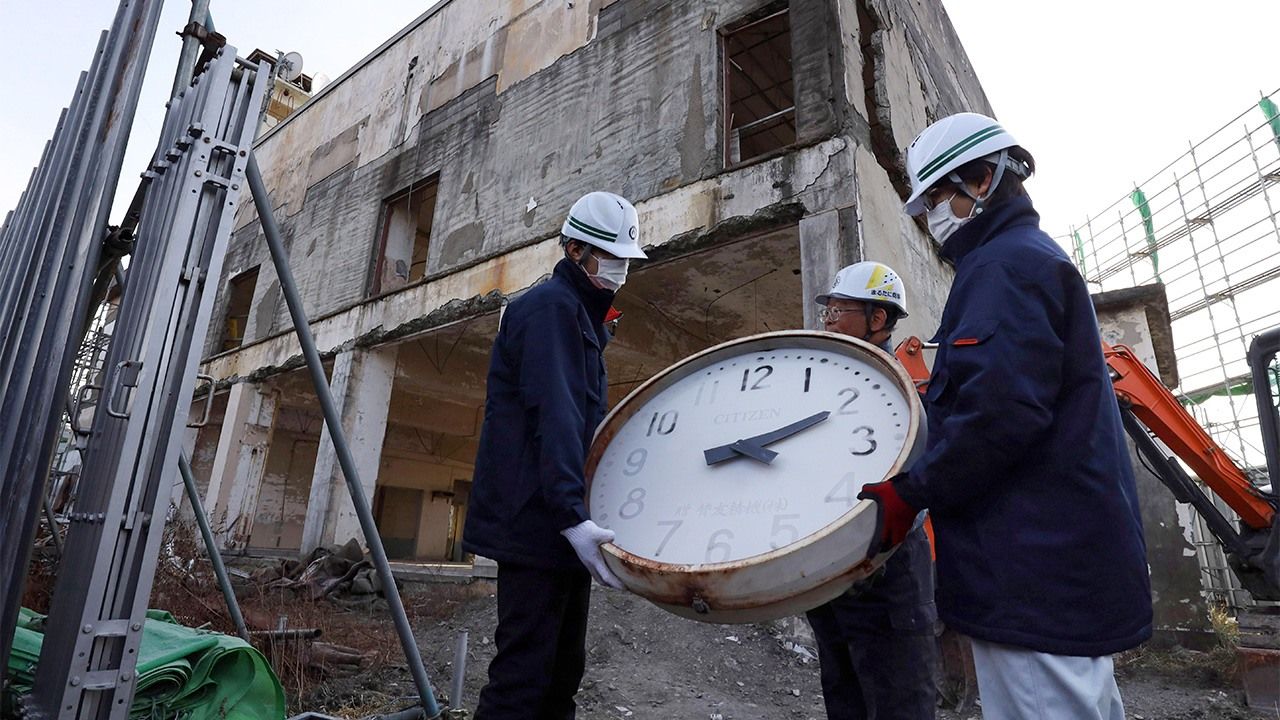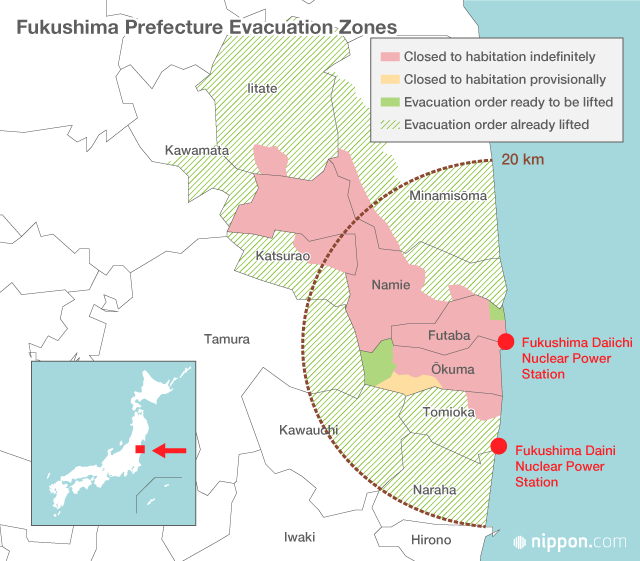
The State of Recovery in Tōhoku Eight Years after 3/11
Society- English
- 日本語
- 简体字
- 繁體字
- Français
- Español
- العربية
- Русский
Evacuees Decline to 54,000
According to Reconstruction Agency figures, over the last year more than 20,000 people displaced by the Great East Japan Earthquake have moved from provisional accommodations to permanent housing. As of January 2019, though, approximately 54,000 evacuees remain in temporary lodging, including around 5,000 in temporary prefabricated structures.
The numbers, however, do not include evacuees from Fukushima who fled from areas outside of designated evacuation zones in the wake of the nuclear accident at Tokyo Electric Power Company’s Fukushima Daiichi Nuclear Power Station. Authorities in late March 2017 ended a policy of providing housing support for these “voluntary evacuees” and no longer include them in overall figures.
The stress of residing in temporary living conditions continues to take a toll on evacuees. Over the past year there were around 50 fatalities indirectly caused by the disaster, so-called disaster-related deaths that include suicide and deteriorating physical health brought on by changes in the living environment.
| 2018 | 2019 | |
|---|---|---|
| Deaths1 | 15,894 | 15,897 |
| Missing1 | 2,546 | 2,534 |
| Disaster-related deaths2 | 3,647 | 3,701 |
| Evacuees3 | Around 75,000 | Around 54,000 |
| Temporary housing units4 | Around 20,000 | Around 5,000 |
1. National Police Agency figures, as of December 10, 2018
2. Reconstruction Agency figures, cumulative total as of late September 2018
3. Reconstruction Agency figures, as of December 2018
4. Reconstruction Agency figures, as of November 2018
Housing Projects Nearly Complete
The Reconstruction Agency expects public housing projects for disaster victims, some 30,000 units of public housing and 18,000 elevated plots for private homes, will be completed by the end of March. Authorities will next shift focus to infrastructural issues like improving transportation networks and bolstering health and nursing care access.
Housing
| 2014 | 2016 | 2019 | |
|---|---|---|---|
| Public housing units for disaster victims | 9% complete | 58% complete | Expected to be nearly 100% complete |
| Finished or partially finished homes | 111,000 | 127,000 | About 140,000 (nearly all planned homes) |
| Elevated plots for private homes | 5% complete | 45% complete | Expected to be nearly 100% complete |
Reconstruction Agency figures, as of January 2019
Recovery Uneven Across Core Sectors
Overall production in manufacturing, agriculture, and other key sectors in Fukushima, Iwate, and Miyagi Prefectures have largely returned to predisaster levels. In tsunami-stricken areas, 89% of farmland has been restored and 96% of seafood processing facilities have resumed operations.
A survey of companies receiving government assistance through a program for small and medium-sized businesses showed that 46% of recipient firms report sales have recovered but that the level of improvement varied considerably by sector.
Agriculture and Fisheries
| 2014 | 2018 | 2019 | |
|---|---|---|---|
| Restored farmland | 63% | 84% | 89% |
| Reopened seafood processing plants | 80% | 93% | 96% |
Reconstruction Agency figures, as of January 2019
Fukushima Evacuation Orders Steadily Lifting
Following the Japanese government in 2017 lifting evacuation orders in several areas around the Fukushima Daiichi plant, only seven municipalities, including all of Futaba and Ōkuma and portions of Namie and four other towns, remain closed to habitation.

The State of Recovery in Tōhoku Seven Years After 3/11
Authorities have officially designated three areas in the evacuation zone: Area 1, where it is expected that residents will have difficulty returning for a long time; Area 2, in which residents are not permitted to live; and Area 3, in which evacuation orders are expected to be lifted. Since April 2014 the government has lifted evacuation orders in 11 municipalities.
Evacuation orders for some areas of Ōkuma, where the Daiichi plant is located, are expected to be lifted in April, allowing a portion of the town’s roughly 10,000 residents to return home eight years after the disaster. In preparation, a new town hall is under construction in the Ōgawara district in the west of the municipality.
In other areas, many evacuees are preparing or have already returned to their homes, although a significant number are unwilling or unable to return and have decided to stay where they are. According to a survey conducted by the Reconstruction Agency in 2015 and 2016, over half of the residents of affected areas in Ōkuma, Futaba, Namie, and Tomioka said they did not intend to return to their homes.
As of January 2019, approximately 32,000 of Fukushima’s roughly 42,000 evacuees reside in other prefectures. Authorities have largely finished decontamination, including of homes and public facilities, and airborne radiation levels continue to decline across the prefecture.
Decommissioning Daiichi: Robot Makes First Contact with Nuclear Debris
Decommissioning of Fukushima Daiichi, the site of Japan’s worst nuclear accident, is moving ahead slowly. Since 2017 investigators have used robotic probes and other equipment to investigate inside Units 1, 2, and 3. In February 2019, a robot equipped with pinchers lowered inside Unit 2 touched melted nuclear fuel debris for the first time.
In September 2017 the government and TEPCO revised their decommissioning “roadmap” for the first time in two years. The final decisions on how to remove melted fuel and the order in which decommissioning work on reactors will take place were deferred until fiscal 2019. The scheduled start of removing spent fuel rods from pools inside Units 1 and 2 was also postponed for three years and is now tentatively set to get underway in 2023. The roadmap, however, retained its 30–40-year timeframe for decommissioning the Daiichi plant.
Government and TEPCO Ordered to Pay Damages
The last twelve months has seen rulings in a number of class-action suits over the meltdown at the Fukushima Daiichi plant, with the courts ordering the government and TEPCO to compensate evacuees.
The Yokohama District Court on February 20, 2019, ordered the state and nuclear plant operator to pay ¥420 million in damages to 152 of 175 plaintiffs who evacuated to Kanagawa Prefecture following the nuclear disaster. The judge ruled that the state and TEPCO could have foreseen the tsunami risk and taken steps to prevent damage to the reactors and subsequent meltdown.
In an ongoing criminal trial of three former TEPCO executives, including then chairman Katsumata Tsunehisa, court-appointed lawyers acting as prosecutors in December 2018 requested five-year prison terms for the trio for their alleged failure to prevent the nuclear accident.
(Originally published in Japanese. Banner photo: Workers in Ōtsuchi, Iwate Prefecture, remove a clock from the outer wall of the former town hall on January 15, 2019. The tsunami-damaged structure was set to be demolished, but many local residents voiced opposition to the move, arguing that it should be kept as a memorial to 3/11. © Jiji.)